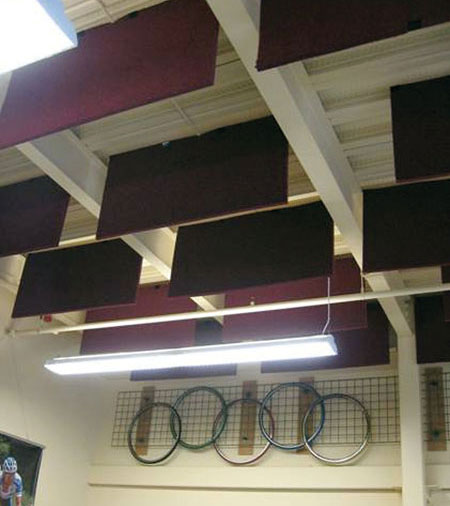Whole System Acoustical Treatments
Using a Whole System Approach to Acoustic Design
By now it is clear that there are multiple factors to consider in achieving the desired acoustical performance for green buildings and for school buildings in particular. As with all requirements in the ANSI Standard S12.60-2002, it is the architect or designer's responsibility to take the necessary steps in specification and design, but careful construction and installation will obviously be necessary to ensure compliance. To begin with, in order to meet the maximum background noise levels of 35 or 40 dBA called for, attention to sound needs to start early in the design phase of a project. Simple strategies such as locating noisy areas away from quieter areas help reduce the presence of sound in unwanted spaces to begin with. Then, the design of all of the wall, ceiling, and floor assemblies needs to be reviewed for meeting STC ratings and outdoor noise control. This will require some review of ratings of common construction assemblies, but also some calculations in order to verify and discern whether or not additional sound insulation or other measures are needed in these assemblies. In order to specifically address the HVAC system noise identified in LEED for Schools, close collaboration between project architects and engineers is crucial. The goal is to design and specify a complete HVAC system including equipment mounting, ductwork, etc. that can achieve a Noise Criteria of approximately 25-35 based on ASHRAE Fundamentals. This may require the use of duct liners or insulation that absorb and diminish the HVAC sound from equipment or airflow. Specific products are available for this and should be coordinated between the different design disciplines so they are properly specified and installed to perform quietly. It is also important to discuss sound control options with the plumbing and electrical engineers to isolate any background noise in those systems and address them in an appropriate manner.
 |
Acoustic panels hung from ceilings improve the overall acoustic performance in those spaces. Photo courtesy of Acoustical Surfaces, Inc. |
If a multi-story educational facility is being designed, then IIC ratings will be an important consideration in reducing background noise, particularly from upper floors. The floor/ceiling system should be specified and constructed in order to create spaces quiet enough to maintain the speech and teaching functions without distraction. Installing carpet on the floor above is one example of ways to reduce impact sounds. But it may also be necessary to isolate the finished floor from the structural floor or to isolate the ceiling from the floor above. For any vibrating machinery located on the floor above or on the roof structure, rubber pads or spring systems should be installed to avoid the creation of noise or its transfer.
Once the background, HVAC, and impact noise issues have been resolved, then the focus needs to turn to the control of reverberation within the interior spaces. Once again, it is the architect or designer's responsibility to ensure that a space meets the required reverberation times by providing the appropriate amount of sound absorption to control RT. Since the stated variables that affect the RT include the volume of the space and the amount of sound absorption within the room, both must be looked at. The volume is likely a function of the owner's program requirements, but the resulting size will have an impact on reverberation in general which the design professional needs to take into consideration. Then, in order to determine the amount of sound absorption present, a material's NRC multiplied by the surface area for the exposed materials in the space must be calculated. Once the amount of absorption for each material has been calculated, the sum of these will give the total amount of sound absorption within the room. Laboratory certified sound absorption coefficients should be available from all of the material manufacturers. In order to achieve the required reverberation time, acoustical treatments will likely be necessary on either the walls or the ceiling, or possibly both. When reverberation time is considered during the design phase, the acoustical treatments are then an integrated part of the design rather than an unwanted add-on.
Finally, the choice of material is critically important for many reasons as already discussed. But longevity and durability are also important for it to hold up over time and under normal use conditions. Some acoustic materials, for example, are generally considered to be impact- and abuse-resistant but when applied directly to a wall, their acoustical performance is very low. While their acoustical performance can be improved dramatically with the addition of fiberglass behind it, the increase in cost significantly surpasses the cost of other options that are also abuse resistant, non-abrasive, non-shedding on impact and weigh less. Similarly, hanging acoustical ceiling baffles are often considered for larger spaces to control RT and maintain sound qualities. Such baffles made from fiberglass can raise handling and indoor environmental quality issues due to their exposure to people. Renewable, natural materials, such as acoustic cotton, can be a cost-effective solution for durable, abuse-resistant acoustical baffles with high-performance noise-reducing characteristics without the handling or environment concerns.
Conclusion
Addressing all aspects of sound control and noise reduction beginning during the early design process of a building can yield some very positive results. These include the readily apparent acoustic qualities of the space with notably less background noise and fewer echoes due to shorter reverberation times of sound. But beyond these immediate auditory sensory benefits, the users of these spaces will be the true beneficiaries by reaping ongoing rewards. Teachers or others speaking in the rooms will find that they can communicate in normal voice tones and levels without extra exertion. Students and those listening will find that they can more easily understand what is being said, will have fewer distractions, and can expect to retain what they learn longer. All involved can take satisfaction in creating a whole system approach to sound control that creates a building that is well designed and meets this newest standard of sustainability.
Bonded Logic, Inc. manufactures recycled insulating products that are good for both you and the environment in which you live. With a focus on performance and sustainability, Bonded Logic has a solution for your insulation challenges. www.bondedlogic.com |
|
| Acoustical Surfaces, Inc. has been solving soundproofing, noise control, acoustical and vibration problems for over 25 years. ASI offers over 2,500 specialty soundproofing, noise control products and a full line of LEED eligible acoustical products. www.acousticalsurfaces.com |









